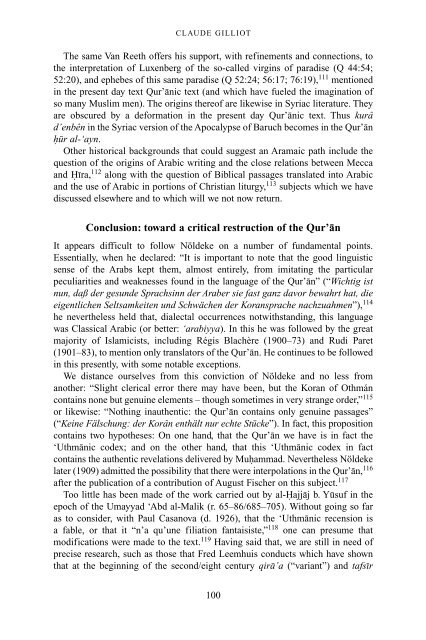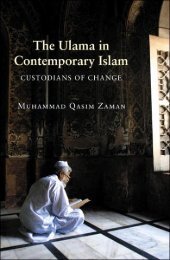The Qur'an in its historical context (pdf - Islam and Christian-Muslim ...
The Qur'an in its historical context (pdf - Islam and Christian-Muslim ...
The Qur'an in its historical context (pdf - Islam and Christian-Muslim ...
You also want an ePaper? Increase the reach of your titles
YUMPU automatically turns print PDFs into web optimized ePapers that Google loves.
CLAUDE GILLIOT<br />
<strong>The</strong> same Van Reeth offers his support, with ref<strong>in</strong>ements <strong>and</strong> connections, to<br />
the <strong>in</strong>terpretation of Luxenberg of the so-called virg<strong>in</strong>s of paradise (Q 44:54;<br />
52:20), <strong>and</strong> ephebes of this same paradise (Q 52:24; 56:17; 76:19), 111 mentioned<br />
<strong>in</strong> the present day text Qur’anic text (<strong>and</strong> which have fueled the imag<strong>in</strong>ation of<br />
so many <strong>Muslim</strong> men). <strong>The</strong> orig<strong>in</strong>s thereof are likewise <strong>in</strong> Syriac literature. <strong>The</strong>y<br />
are obscured by a deformation <strong>in</strong> the present day Qur’anic text. Thus kurâ<br />
d’enbên <strong>in</strong> the Syriac version of the Apocalypse of Baruch becomes <strong>in</strong> the Qur’an<br />
hur al-‘ayn.<br />
Other <strong>historical</strong> backgrounds that could suggest an Aramaic path <strong>in</strong>clude the<br />
question of the orig<strong>in</strong>s of Arabic writ<strong>in</strong>g <strong>and</strong> the close relations between Mecca<br />
<strong>and</strong> Hira, 112 along with the question of Biblical passages translated <strong>in</strong>to Arabic<br />
<strong>and</strong> the use of Arabic <strong>in</strong> portions of <strong>Christian</strong> liturgy, 113 subjects which we have<br />
discussed elsewhere <strong>and</strong> to which will we not now return.<br />
Conclusion: toward a critical restruction of the Qur’an<br />
It appears difficult to follow Nöldeke on a number of fundamental po<strong>in</strong>ts.<br />
Essentially, when he declared: “It is important to note that the good l<strong>in</strong>guistic<br />
sense of the Arabs kept them, almost entirely, from imitat<strong>in</strong>g the particular<br />
peculiarities <strong>and</strong> weaknesses found <strong>in</strong> the language of the Qur’an” (“Wichtig ist<br />
nun, daß der gesunde Sprachs<strong>in</strong>n der Araber sie fast ganz davor bewahrt hat, die<br />
eigentlichen Seltsamkeiten und Schwächen der Koransprache nachzuahmen”), 114<br />
he nevertheless held that, dialectal occurrences notwithst<strong>and</strong><strong>in</strong>g, this language<br />
was Classical Arabic (or better: ‘arabiyya). In this he was followed by the great<br />
majority of <strong>Islam</strong>icists, <strong>in</strong>clud<strong>in</strong>g Régis Blachère (1900–73) <strong>and</strong> Rudi Paret<br />
(1901–83), to mention only translators of the Qur’an. He cont<strong>in</strong>ues to be followed<br />
<strong>in</strong> this presently, with some notable exceptions.<br />
We distance ourselves from this conviction of Nöldeke <strong>and</strong> no less from<br />
another: “Slight clerical error there may have been, but the Koran of Othmán<br />
conta<strong>in</strong>s none but genu<strong>in</strong>e elements – though sometimes <strong>in</strong> very strange order,” 115<br />
or likewise: “Noth<strong>in</strong>g <strong>in</strong>authentic: the Qur’an conta<strong>in</strong>s only genu<strong>in</strong>e passages”<br />
(“Ke<strong>in</strong>e Fälschung: der Korân enthält nur echte Stücke”). In fact, this proposition<br />
conta<strong>in</strong>s two hypotheses: On one h<strong>and</strong>, that the Qur’an we have is <strong>in</strong> fact the<br />
‘Uthmanic codex; <strong>and</strong> on the other h<strong>and</strong>, that this ‘Uthmanic codex <strong>in</strong> fact<br />
conta<strong>in</strong>s the authentic revelations delivered by Muhammad. Nevertheless Nöldeke<br />
later (1909) admitted the possibility that there were <strong>in</strong>terpolations <strong>in</strong> the Qur’an, 116<br />
after the publication of a contribution of August Fischer on this subject. 117<br />
Too little has been made of the work carried out by al-Hajjaj b. Yusuf <strong>in</strong> the<br />
epoch of the Umayyad ‘Abd al-Malik (r. 65–86/685–705). Without go<strong>in</strong>g so far<br />
as to consider, with Paul Casanova (d. 1926), that the ‘Uthmanic recension is<br />
a fable, or that it “n’a qu’une filiation fantaisiste,” 118 one can presume that<br />
modifications were made to the text. 119 Hav<strong>in</strong>g said that, we are still <strong>in</strong> need of<br />
precise research, such as those that Fred Leemhuis conducts which have shown<br />
that at the beg<strong>in</strong>n<strong>in</strong>g of the second/eight century qira’a (“variant”) <strong>and</strong> tafsir<br />
100



